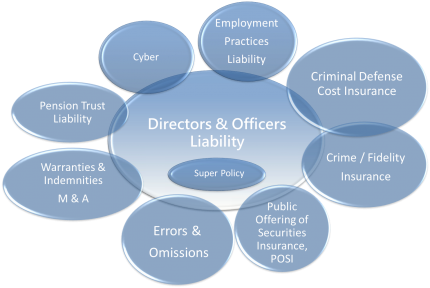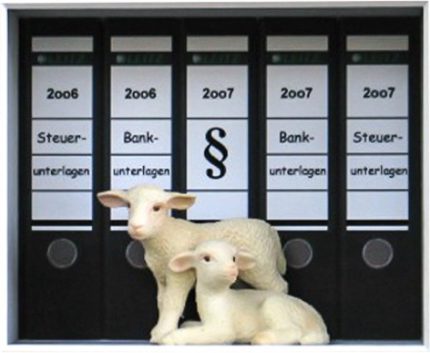There are inseparable relationships between the various Financial Lines. We take care of the important reconciliation processes for you. This is difficult. Hardly any insurer offers all the products. Not every offer corresponds at least to the market standard. The products are not coordinated, although they have many interfaces. There are always other insurances that seem to be closer to the loss if a claim is reported. The general insurance conditions are revised on average every two years and there are also changes for the worse. The terms and the product structure are inconsistent. The sale of new cover components is always based on current loss experience in practice. This is sometimes, unfortunately, only a claim that can be expensive for the insured. We make this simple to save you from irritation. Our special products for our customers serve some insurers as a template for their next product revision.
Financial Lines: widespread responsibilities
| Responsibility | for | Financial Lines & Claims |
| Creditinsurer | Commercial Crime /Fidelity | |
| Legal expense cost insurer | Criminal Defense Cost CoverManager Legal Cost Cover | |
| Liability Insurer Germany | Directors & Officers | |
| Liability Insurer USA/UK | Employment Practices LiabilityPension Trust Liability | |
| Property-/Electronic Insurer | Cyber-/Business Interruption | |
| P&C Insurer USA/UK | Kidnapping, Ransom & Extortion connected to Security Services | |
| Specialty Insurer USA/UK | Financial Lines package policies |
The words „product” and “claims“ are for the separate departments. In financial lines, coordination and communication costs are extremely high. The fact that this is a matter for the boardroom is an additional problem. We have a lot of experience and you can only profit from it.
When we act as brokers in the Financial Lines for you, we promise you to create order in this dynamic chaos. When we deal with your D&O, we spend half of our time with the Financial Lines interfaces, gaps and misunderstandings:
Gaps in the presentation of your overall risk
- Gaps in the representation of insurability
- Placebo co-insurance in existing policies (eg inclusion of the pension trustee coverage in the D&O policy)
- Missing policies
- Double insurances
- Denied claims regulation based on the priority of other financial lines
- Lack of synchronization between the policies (different subsidiary definitions, differing claims made rules)
- Sector delimitations in the existing policies are not recognized, not adapted and often not reported.
There are communication needs at all levels ranging from the templates for the management and executive board to the discussion about the allocation of the invoice documents with the insurers’ claims administrators.
Why is this market so complex? Why is there no well-matched Financial Lines insurance market in Germany? This would lead to improvements in all aspects among others: to better product standards, faster service, more comprehensive knowledge for advice and in case of losses, cost reduction and more overall satisfaction. The answer is simple: D&O insurance has only recently been the focus of the Financial Lines. D&O is a young class of insurance business and only little change can be expected in the near future. The establishment of an insurance company lasts for decades. With little claims experience in the beginning, the requirement for coordination is not recognized until many years later. This need for coordination and gap closure is only the beginning of a tedious and protracted process. The change management against the acquired rights in the insurance departments is, as experience shows, slow. This work has to be done in Germany. However, the speed of innovation among the Financial Lines is high and growing. These innovations come mainly from the USA. The Financial Lines are an aspect of the dynamics of the American financial market. In particular, the Directors & Officers insurance is to be seen in the context of shareholder value, compliance and corporate governance. Slimmer balance sheets with a higher vulnerability to financial losses and simultaneously increasing requirements on financial reporting, are the driving forces for the Financial Lines.
When and where the individual insurers and brokers in Germany established their Financial Lines units differs. It did not necessarily have to happen where the knowledge for the risk was the highest. Once a competence is established, it is also defended. The commercial crime insurance is an annexed product of the credit insurance sector. Top-manager legal protection products are located in the legal protection insurance. D&O insurance began in the industrial liability insurance or professional liability insurance departments. For EPL and AGG policies, the demand for purely German risks is growing only at a slow rate. Additionally, there is only a gradual interest for the fiduciary or pension trust liability in Germany. It was only in 2000 that the provisions for pensions were outsourced from the consolidated balance sheets into pension fund assets. Organ liability risks and risks from day-to-day business will increase as the number of retirees grows and interest rates shrink. The deterioration of this risk is known from the life insurance sector. Good German products with global recognition are still rare in the areas of employment practices liability and pension trust liability. In Germany, the insurance of risk-of-ransom risks is only possible to a very limited extent. D&O insurance still applies to reservations in Germany. This was last observed in 2009 with the introduction of the prohibition of non-deductible co-insurance of board members in the corporate policies of stock corporations.
Risk management is no longer possible without the integrated inclusion of the Financial Lines. It is no longer enough to just talk about the D&O insurance. An insurance case at D&O always raises the question as to whether other Financial Lines products could be affected, or whether a rejection of D&O insurance is to be expected because other products are missing. However, then it is too late. We will be happy to explain the interaction of the various products by means of the current cases in the daily press. The years of accusations of the media show why D&O insurance alone is not enough anymore.

















